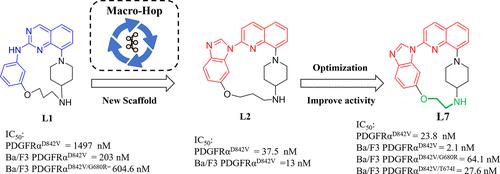Designing Macrocyclic Kinase Inhibitors Using Macrocycle Scaffold Hopping with Reinforced Learning (Macro-Hop)
IF 6.8
1区 医学
Q1 CHEMISTRY, MEDICINAL
引用次数: 0
Abstract
Macrocycles have gained significant attention in drug discovery, with over 70 macrocyclic compounds currently in clinical use. Despite this progress, the effective methods for designing macrocycles remain elusive. In this study, we present Macro-Hop, a reinforced learning framework designed to rapidly and comprehensively explore the macrocycle chemical space. Macro-Hop efficiently generates novel macrocyclic scaffolds that not only align with predefined physicochemical properties but also exhibit 3D structural similarities to a specified reference compound. As a proof of concept, we applied Macro-Hop to design a new series of macrocycle inhibitors targeting PDGFRαD842 V kinase. The representative compound L7 exhibited high potency against PDGFRαD842 V in both biochemical and cellular assays with IC50 values of 23.8 and 2.1 nM, respectively. L7 effectively inhibited clinically relevant secondary mutants PDGFRαD842 V/G680R (IC50 = 64.1 nM) and PDGFRαD842 V/T674I (IC50 = 27.6 nM), highlighting the rapid effectiveness of wet-leb validation with Macro-Hop.

基于强化学习的大环支架跳跃(macrohop)设计大环激酶抑制剂
大环化合物在药物发现中受到了极大的关注,目前有70多种大环化合物在临床应用。尽管取得了这些进展,但设计大环的有效方法仍然难以捉摸。在这项研究中,我们提出了Macro-Hop,一个强化的学习框架,旨在快速和全面地探索大环化学空间。Macro-Hop有效地生成新的大环支架,不仅符合预定的物理化学性质,而且具有与特定参考化合物相似的3D结构。为了验证这一概念,我们应用Macro-Hop设计了一系列新的靶向PDGFRαD842 V激酶的大环抑制剂。具有代表性的化合物L7对PDGFRαD842 V具有较高的抑制作用,其IC50值分别为23.8 nM和2.1 nM。L7有效抑制临床相关的继发性突变体PDGFRαD842 V/G680R (IC50 = 64.1 nM)和PDGFRαD842 V/T674I (IC50 = 27.6 nM),突出了Macro-Hop湿脚验证的快速有效性。
本文章由计算机程序翻译,如有差异,请以英文原文为准。
求助全文
约1分钟内获得全文
求助全文
来源期刊

Journal of Medicinal Chemistry
医学-医药化学
CiteScore
4.00
自引率
11.00%
发文量
804
审稿时长
1.9 months
期刊介绍:
The Journal of Medicinal Chemistry is a prestigious biweekly peer-reviewed publication that focuses on the multifaceted field of medicinal chemistry. Since its inception in 1959 as the Journal of Medicinal and Pharmaceutical Chemistry, it has evolved to become a cornerstone in the dissemination of research findings related to the design, synthesis, and development of therapeutic agents.
The Journal of Medicinal Chemistry is recognized for its significant impact in the scientific community, as evidenced by its 2022 impact factor of 7.3. This metric reflects the journal's influence and the importance of its content in shaping the future of drug discovery and development. The journal serves as a vital resource for chemists, pharmacologists, and other researchers interested in the molecular mechanisms of drug action and the optimization of therapeutic compounds.
 求助内容:
求助内容: 应助结果提醒方式:
应助结果提醒方式:


